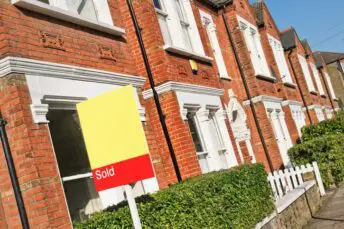House Price Index Nov 2025
After a long lead-in, the budget proved more bark than bite, though pre-budget speculation did weigh on November activity. Annual house price growth, buyer demand, new seller instructions and sales agreed all declined. Ultimately, the property tax changes announced are not expected to have a material impact on the market, and with greater certainty, activity is expected to rebound in the new year—supported by improving affordability, as house price growth continues to lag earnings growth and mortgage rates trend lower. We are forecasting gradual house price growth in 2026 of 2%.
What’s happening nationally
House prices are up on average +0.1% in the past month and +1.4% in the past year.
House prices have nudged up over the past month +0.1% on average across the indices. Land Registry reporting October figures is -0.1%, Nationwide +0.3% in November, Halifax +0% in November and Rightmove reporting November asking prices is up -1.8%.
Annual house price growth is positive but the rate of growth slowed this month to 1.4% down from 2.2% last month. The indices report the following shifts in annual house price growth over the past month: Land Registry (1.7% vs 2.6%), Nationwide (1.8% vs 2.4%), Halifax (0.7% vs 1.9%) and Rightmove reporting asking prices (-0.5% vs -0.1%).
Note that there has been a change of methodology in the calculation of the Land Registry house price index. From February 2025 reporting, January 2023 became the new reference period for inflation rates. Land Registry has been re-referenced because the types of property being sold can change over time.
Indices based on:
Land Registry – registered property transactions in October.
Nationwide & Halifax – mortgage valuations in November.
Rightmove – asking prices posted on Rightmove in November.
*Rightmove is not included in the index average as the basis for its index is different (asking price vs agreed sale price)
| Index reports: | Monthly change | Annual change |
|---|---|---|
| Land registry | -0.1% | +1.7% |
| Nationwide | +0.3% | +1.8% |
| Halifax | +0% | +0.7% |
| Rightmove | -1.8% | -0.5% |
| Average change | +0.1% | +1.4% |
House prices in your area
Regional house prices
House prices are down overall in England -0.1%, down in Scotland -0.6% and up in Wales +1.1% and up in Northern Ireland +4.3%. In England house prices this month were on the up in: the North East (+1.3%), North West (+0.3%), East of England (+0.3%), South East of England (+0.3%) and West Midlands (+0.1%). House prices were down sharply in London (-1.9%).
UK annual house price inflation has slowed in most regions in England (+1.4% overall). Areas with a fall or slowest growth in house prices include: London (-2.4%) and the South West (-1.3%). Areas in England with stronger growth include the North East (+5.0%), Yorkshire & Humber (+3.1%), the North West (3.1%), West Midlands (+2.7%) and East Midlands (+2.3%). UK regions with the highest annual growth include Northern Ireland +7.1% and Scotland +3.3%.
Most expensive/ cheapest areas
In terms of average house price, the most expensive regions in the UK are London (£548K), the South East (£383K), the East of England (£340K) and the South East (£383K). The cheapest regions are the North East of England (£163K), Northern Ireland (£193K), Scotland (£192K), Yorkshire & Humber (£206K) and Wales (£211K).
In terms of cities, the most affordable are: Aberdeen (£138K), Glasgow (£159K), Newcastle (£161K) and Sheffield (£177K). And, the most expensive cities in the UK are: London (£530K), Cambridge (£469K), Oxford (£448K), Bristol (£343K) and Bournemouth (£318K).
Prices by property type
House prices shifted in the last year for detached (+1.7%), semi-detached (+4.0%), terraced (+2.8%) properties and for flats/ maisonettes (-2.6%).
| UK Region | Average price £ | Monthly change | Annual change |
|---|---|---|---|
| England | |||
| Nothern Ireland | |||
| Scotland | |||
| Wales | |||
| North West | |||
| Yorkshire and The Humber | |||
| North East | |||
| West Midlands | |||
| East Midlands | |||
| South West | |||
| East of England | |||
| South East | |||
| London |
| UK City | Average price | Annual change |
|---|---|---|
Market Monitor
October transactions of 98.5K are up 2% vs September (97k) and down -2% on transactions last October (100.6K).
Buyer demand, new instructions and sales agreed fall, while time to sell increases.
In November, buyer demand fell further to the weakest level since late 2023 and new seller instructions also fell.
Zoopla reports that buyer demand is 12% lower and sales agreed 4% lower than a year ago.
The average time to secure a buyer increased to 70 days in November up from 66 days in October according to Rightmove; above the 2025 average (which is 65 days).
How busy is the market?
- Not busy
- Normal
- Very busy
- Transactions in October are up slightly
- Total transactions in October 2025 98.5K
- +2% versus last month
- -2% lower than last year
Homes for sale vs homebuyers
- Good availability of homes
- Normal
- Shortage of homes
- Buyer enquiries fall (-32% RICS Nov data) weakest reading since late 2023
- Seller instructions down (-19% RICS Sept data) 4th monthly fall after 13 successive rises
- Average stock per agent 61 in November; down from 64 last month (incl under offer/ Sold STC Rightmove)
Average speed of sale
- Fast
- Normal
- Slow
- Nov figure: 70 days to find a buyer, up from 66 days last month; above year to date average of 65 days (Rightmove)
What the experts say
Rightmove

“The average price of property for sale has fallen by 1.8%. Prices usually fall in December, but this year’s price fall is larger than the ten-year average drop of 1.4%. It means that 2025 ends with average asking prices 0.6% lower than a year ago. Budget-related gloom and uncertainty have amplified the seasonal slowdown in prices and activity that we’d usually see in December and indeed contributed to a more subdued second half of the year overall. Rightmove predicts that the 2026 market will be more like the encouraging first half of this year, rather than the second half, where confidence was affected by Budget speculation. Buyer affordability is set to improve, and the good choice of homes for sale continues to run at a decade-high level. For these reasons, Rightmove predicts stronger housing market activity, leading to modest upwards price pressure, and causing the average price of property coming to the market for sale to rise by 2% in 2026.”
Nationwide

“2025 House prices evolved broadly in line with our expectations. Annual price growth slowed steadily from 4.7% at the end of 2024 to 2.1% in the middle of 2025 and then to 1.8% in November. With price growth well below the rate of earnings growth and a steady decline in mortgage rates, affordability constraints eased somewhat, helping to underpin buyer demand. First-time buyer share of house purchase activity was above the long run average, supported by easier credit availability, with the share of high loan to value lending (i.e. with a deposit of 15% or less) reaching its highest level for over a decade. Looking ahead, we expect housing market activity to strengthen a little further as affordability improves gradually via income growth outpacing house price growth and a further modest decline in interest rates. We expect annual house price growth to remain in the 2 to 4% range next year. Changes to property taxes announced in the Budget are unlikely to have a significant impact. The high value council tax surcharge is not being introduced until April 2028 and will apply to less than 1% of properties in England and about 3% in London. Higher taxes on income from properties may dampen buy-to-let activity further.”
Zoopla (Hometrack)

“The usual Christmas slowdown has started earlier than usual with buyer demand now 12% lower than a year ago. Even so, sales agreed are only 4% lower, as committed buyers push to secure deals before the end of the year. With greater clarity on the future of property taxation for buyers and sellers, we expect market activity to pick up as we enter 2026, following what has been almost a four-month slowdown in late 2025. Our data shows the underlying demand to move home remains strong. With greater certainty, we expect a rebound in housing market activity that builds into the new year, with households who paused homemoving decisions over recent months return with greater confidence. We think house price growth will be closer to 1% by the end of 2025, and we expect this slower pace to continue into 2026.”
Halifax

“Average house prices were broadly unchanged in November. Annual growth has slowed to +0.7%, the weakest rate since March 2024, though this largely reflects the base effect of much stronger price growth this time last year. This consistency in average prices reflects what has been one of the most stable years for the housing market over the last decade. Even with the changes to Stamp Duty back in spring and some uncertainty ahead of the Autumn Budget, property values have remained steady. While slower growth may disappoint some existing homeowners, it’s welcome news for first-time buyers. Comparing property prices to average incomes, affordability is now at its strongest since late 2015. Mortgage costs as a share of income are at their lowest level in around three years. Looking ahead, with market activity steady and expectations of further interest rate reductions to come, we anticipate property prices will continue to grow gradually into 2026.”
RICS

“The November 2025 RICS UK Residential Market Survey results continue to portray a subdued backdrop, with metrics on buyer demand and sales volumes still firmly in negative territory. Moreover, forward-looking indicators have yet to suggest any meaningful near-term improvement, with the tone of the data showing no discernible reaction to the recent Budget (three-quarters of the sample was gathered after the event). Looking at the longer term, it is anticipated that house prices will resume an upward trajectory over the coming year (the strongest reading since June).”




